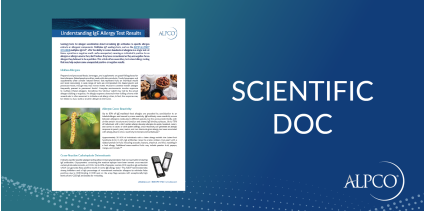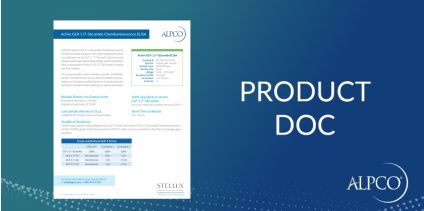Fetuin-A ELISA
$913.00
Catalog
43-FETHU-E01
The Fetuin-A ELISA is an enzyme immunoassay for the quantitative determination of human Fetuin-A, also known as alpha-2-HS glycoprotein (AHSG), in serum. Research Use Only. Not for Use in Diagnostic Procedures.
Species
Human
Regulatory Status
Research Use Only. Not for Use in Diagnostic Procedures.
Product Distribution
Available Worldwide
Range
0.5 - 3.7 ng/mL
Sensitivity
5 ng/mL
Sizes
96 Wells
Sample Types
Cell Culture, Plasma, Serum, Tissue Culture, Urine
Inc Time Hour
3
Inc Time Overnight
No
Inc Time See Protocol
No
Sample Size
10
Detection
Colorimetric
Fetuin-A, also known as alpha-2-HS glycoprotein, is a 59 kDa glycoprotein that consists of two amino-terminal cystatin domains and a smaller carboxyl-terminal domain. Fetuin-A is synthesized by the liver and secreted into blood stream, where its concentration in adult mammals ranges from 0.5 - 1.5 g/L. Fetuin-A occurs in high serum concentration during fetal life. It accumulates in bones and teeth as a major fraction of noncollagenous bone proteins. Studies have demonstrated that Fetuin-A is the major calcification inhibitor found in serum, where it interferes with calcium salt precipitation.
This ELISA is designed, developed and produced for the quantitative measurement of human Fetuin-A in serum samples. The assay utilizes the two-site “sandwich” technique with two selected goat anti-human Fetuin-A polyclonal antibodies that bind to different epitopes of human Fetuin-A. Assay standards, controls and prediluted serum samples containing human Fetuin-A are added to microtiter wells of a microplate coated with a high affinity polyclonal goat anti-human Fetuin-A antibody. After the first incubation period, the antibody on the wall of microtiter well captures human Fetuin-A in the sample and unbound proteins in each microtiter well are washed away. Then a horseradish peroxidase (HRP) conjugated polyclonal anti-human Fetuin-A antibody is added to each microtiter well and a “sandwich” of “capture antibody - human Fetuin-A - HRP conjugated tracer antibody” is formed. The unbound tracer antibody is removed in the subsequent washing step. HRP conjugated tracer antibody bound to the well is then incubated with a substrate solution in a timed reaction and then measured in a spectrophotometric microplate reader. The enzymatic activity of the tracer antibody bound to the Fetuin-A on the wall of the microtiter well is directly proportional to the amount of Fetuin-A in the sample. A standard curve is generated by plotting the absorbance versus the respective human Fetuin-A concentration for each standard on point-to-point or cubical scales. The concentration of human Fetuin-A in test samples is determined directly from this standard curve.
This ELISA is designed, developed and produced for the quantitative measurement of human Fetuin-A in serum samples. The assay utilizes the two-site “sandwich” technique with two selected goat anti-human Fetuin-A polyclonal antibodies that bind to different epitopes of human Fetuin-A. Assay standards, controls and prediluted serum samples containing human Fetuin-A are added to microtiter wells of a microplate coated with a high affinity polyclonal goat anti-human Fetuin-A antibody. After the first incubation period, the antibody on the wall of microtiter well captures human Fetuin-A in the sample and unbound proteins in each microtiter well are washed away. Then a horseradish peroxidase (HRP) conjugated polyclonal anti-human Fetuin-A antibody is added to each microtiter well and a “sandwich” of “capture antibody - human Fetuin-A - HRP conjugated tracer antibody” is formed. The unbound tracer antibody is removed in the subsequent washing step. HRP conjugated tracer antibody bound to the well is then incubated with a substrate solution in a timed reaction and then measured in a spectrophotometric microplate reader. The enzymatic activity of the tracer antibody bound to the Fetuin-A on the wall of the microtiter well is directly proportional to the amount of Fetuin-A in the sample. A standard curve is generated by plotting the absorbance versus the respective human Fetuin-A concentration for each standard on point-to-point or cubical scales. The concentration of human Fetuin-A in test samples is determined directly from this standard curve.







